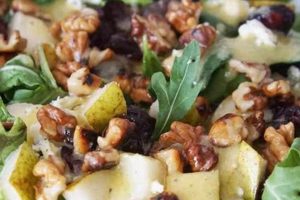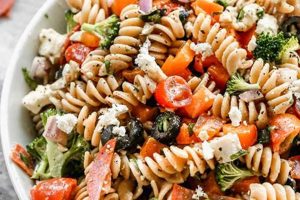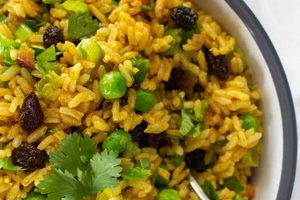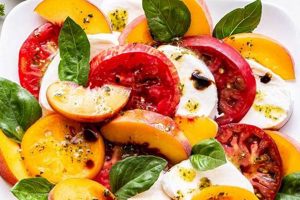Dinner salads transcend the role of a simple side dish, offering a complete and satisfying meal. They typically feature a robust base of greens complemented by substantial ingredients such as grilled or roasted protein (chicken, fish, tofu), hearty grains (quinoa, farro), legumes, a variety of fresh vegetables, and a flavorful dressing. An example might include grilled salmon over a bed of mixed greens with roasted sweet potatoes, avocado, and a lemon-herb vinaigrette.
Nutritious and customizable, these salads offer a versatile approach to healthy eating. They can accommodate dietary restrictions and preferences with ease. Historically, salads have evolved from simple greens with oil and vinegar to complex compositions reflecting culinary trends and regional influences. The contemporary focus on healthy eating has elevated the dinner salad to a prominent position, emphasizing fresh, seasonal ingredients and balanced nutrition.
This article will explore a diverse range of dinner salad recipes, offering guidance on ingredient selection, dressing preparation, and creative combinations to inspire culinary creativity and promote healthy eating habits. From classic combinations to innovative flavor profiles, the possibilities are endless.
Tips for Crafting Exceptional Dinner Salads
Creating a satisfying and nutritious dinner salad involves careful consideration of ingredients, textures, and flavors. These tips offer guidance for composing salads that go beyond basic greens.
Tip 1: Prioritize Seasonal Produce: Selecting produce at its peak ripeness guarantees optimal flavor and nutritional value. A winter salad might feature roasted root vegetables and kale, while a summer salad could showcase juicy tomatoes and fresh corn.
Tip 2: Embrace Variety in Textures: A dynamic salad incorporates a range of textures. Consider crunchy nuts or seeds, creamy avocado, chewy dried fruit, and crisp vegetables alongside tender greens.
Tip 3: Balance Flavor Profiles: Strive for a balance of sweet, salty, sour, and bitter elements. Pair tangy vinaigrette with sweet roasted vegetables or bitter greens with salty cheese.
Tip 4: Protein Power: Elevate the salad to a complete meal with the addition of lean protein. Grilled chicken, fish, tofu, beans, lentils, or hard-boiled eggs all offer excellent options.
Tip 5: Dress Strategically: Avoid overdressing, which can make the salad soggy. Lightly coat the ingredients with a flavorful dressing just before serving.
Tip 6: Grains and Legumes Add Substance: Incorporating cooked grains like quinoa or farro, or legumes such as chickpeas or black beans, provides additional fiber and nutrients, enhancing satiety.
Tip 7: Consider Prepping Ahead: Washing and chopping ingredients in advance saves time and makes assembling a quick and healthy dinner a breeze.
By following these guidelines, one can consistently create flavorful, balanced, and satisfying dinner salads that contribute to a healthy and enjoyable dining experience.
These tips provide a foundation for crafting exceptional dinner salads tailored to individual preferences and dietary needs. The following section will delve into specific recipe examples.
1. Fresh, Seasonal Ingredients
Fresh, seasonal ingredients form the cornerstone of exceptional dinner salads. Produce at its peak ripeness offers superior flavor and nutritional value. This connection is crucial for achieving truly satisfying and healthful meals. Utilizing seasonal ingredients allows salads to reflect the natural flavors of a particular time of year. A winter salad might showcase the earthy sweetness of roasted root vegetables like beets and carrots, while a summer salad could highlight the bright, juicy flavors of ripe tomatoes and cucumbers. This not only enhances the taste but also provides a wider range of nutrients, as produce naturally contains different vitamin and mineral profiles depending on the growing season. Choosing seasonal ingredients reduces reliance on produce transported long distances, thus minimizing environmental impact.
The practical significance of incorporating fresh, seasonal ingredients is multifaceted. Access to locally sourced produce supports local farmers and strengthens community-based food systems. It also fosters a deeper connection to the origins of food and encourages culinary creativity by adapting to the changing availability of ingredients. For example, a spring salad might feature asparagus and peas, while a fall salad could incorporate butternut squash and apples. This adaptability allows for continuous exploration of new flavor combinations and ensures a diverse and interesting culinary experience.
In conclusion, prioritizing fresh, seasonal ingredients elevates dinner salads from basic to exceptional. The superior flavor, enhanced nutritional value, reduced environmental impact, and support for local economies make this practice essential for both personal well-being and sustainable food practices. By embracing the natural rhythm of the seasons, one can create truly outstanding and healthful dinner salads that celebrate the bounty of nature.
2. Balanced Flavor Profiles
Balanced flavor profiles are fundamental to crafting exceptional dinner salads. A harmonious blend of tastes elevates a salad from simple to sophisticated, ensuring a satisfying and enjoyable dining experience. This balance prevents any single flavor from dominating, allowing the complexity of the ingredients to shine through. Achieving this balance requires careful consideration of the interplay between different taste elements.
- Sweetness
Sweetness in a salad can come from various sources, such as fruits (berries, apples, grapes), roasted vegetables (sweet potatoes, beets), or even a touch of honey or maple syrup in the dressing. Sweetness provides a counterpoint to other flavors, preventing the salad from becoming too savory or acidic. For example, the sweetness of roasted butternut squash complements the peppery bite of arugula and the tanginess of a balsamic vinaigrette.
- Acidity
Acidity introduces brightness and complexity. Vinegars (balsamic, red wine, apple cider), citrus juices (lemon, lime), or acidic fruits (grapefruit, pomegranate) provide the necessary tang. Acidity cuts through richness, balances sweetness, and enhances the overall flavor profile. A squeeze of lemon juice brightens a salad with creamy avocado and rich grilled salmon.
- Saltiness
Salt enhances the flavors of other ingredients and provides a savory depth. Salty elements can include cheeses (feta, parmesan, goat), cured meats (prosciutto, pancetta), or simply a sprinkle of sea salt. Salt should be used judiciously to avoid overpowering the other flavors. Salty feta cheese complements the sweetness of roasted beets and the earthiness of walnuts.
- Bitterness
Bitterness adds a sophisticated edge and complexity. Ingredients like bitter greens (kale, arugula, radicchio), olives, or dark chocolate can provide this element. Bitterness contrasts with sweetness and richness, creating a more nuanced flavor profile. The peppery bitterness of arugula balances the sweetness of dried cranberries and the creaminess of goat cheese.
By thoughtfully combining these four flavor elements, one can create salads that are not only nutritionally balanced but also offer a complex and satisfying symphony of tastes. A well-balanced flavor profile ensures each bite is a delightful experience, encouraging mindful eating and appreciation for the diverse flavors present in fresh, wholesome ingredients. This approach elevates dinner salads beyond basic sustenance, transforming them into culinary creations that nourish both body and palate.
3. Variety of Textures
Textural diversity significantly contributes to the enjoyment and satisfaction derived from a dinner salad. A combination of crisp, crunchy, creamy, and chewy elements elevates the sensory experience, making the meal more engaging and appealing. This variety prevents monotony and encourages continued interest in each bite. The interplay of textures adds depth and complexity, transforming a simple salad into a culinary delight. Consider a salad featuring crisp romaine lettuce, crunchy toasted walnuts, creamy avocado slices, and chewy dried cranberries. The contrasting textures create a dynamic and satisfying experience.
The importance of textural variety extends beyond mere enjoyment. Different textures stimulate different receptors in the mouth, enhancing the perception of flavors and creating a more complete sensory experience. A salad with solely soft ingredients can feel bland and uninspiring, while a salad with a range of textures provides a more stimulating and satisfying experience. For example, the crunch of roasted chickpeas provides a delightful contrast to the softness of roasted sweet potatoes and the tenderness of spinach, amplifying the overall flavor profile. Furthermore, varying textures can contribute to improved satiety. The act of chewing crunchy and chewy elements promotes mindful eating, allowing for better digestion and a greater sense of fullness.
Understanding the impact of textural variety empowers one to craft truly exceptional dinner salads. By intentionally incorporating a range of textures, from crisp greens and crunchy nuts to creamy cheeses and chewy dried fruits, individuals can elevate their salads from basic to extraordinary. This understanding not only enhances the enjoyment of the meal but also contributes to a more satisfying and nutritionally complete dining experience. Incorporating a diverse range of textures is a crucial element in crafting dinner salads that are both delicious and healthful.
4. Substantial Protein Sources
Substantial protein sources are essential for transforming a salad from a side dish into a satisfying and complete dinner. Protein provides satiety, supports muscle maintenance and growth, and contributes to overall nutritional balance. In the context of “best salad recipes for dinner,” incorporating adequate protein is crucial for creating meals that are both flavorful and nourishing.
- Lean Meats and Poultry
Grilled or roasted chicken, turkey, or lean cuts of beef provide high-quality protein and contribute savory depth to a salad. Sliced grilled chicken breast atop a bed of mixed greens with roasted vegetables offers a classic example. The lean protein complements the fresh produce and creates a balanced, nutrient-rich meal. These protein sources are versatile and can be seasoned to complement a wide range of flavor profiles.
- Fish and Seafood
Fish, such as salmon, tuna, or shrimp, offers a lighter protein option rich in omega-3 fatty acids. Flaked grilled salmon over a quinoa salad with avocado and a lemon-herb dressing exemplifies this. The healthy fats and protein create a satisfying and flavorful combination. Fish and seafood introduce unique flavor profiles and contribute to a heart-healthy meal.
- Plant-Based Proteins
Plant-based proteins, including beans, lentils, tofu, tempeh, and edamame, offer a vegetarian or vegan alternative. A black bean salad with corn, avocado, and a lime vinaigrette demonstrates this approach. Plant-based proteins offer fiber and a range of essential nutrients. They provide textural diversity and can be incorporated into a variety of flavor profiles.
- Eggs and Dairy
Hard-boiled eggs, crumbled feta cheese, or grilled halloumi contribute protein and enhance the flavor and textural complexity of a salad. A spinach salad with hard-boiled eggs, bacon, and a warm vinaigrette exemplifies this. These additions offer satiety and contribute important nutrients. They also provide opportunities for exploring different flavor combinations and textural contrasts.
By incorporating substantial protein sources, dinner salads become nutritionally complete meals that satisfy hunger and support overall well-being. The choice of protein significantly influences the flavor profile and nutritional value of the salad, offering a range of possibilities for customization and culinary exploration. The inclusion of protein ensures that dinner salads offer a balanced and satisfying meal, promoting healthy eating habits and culinary creativity.
5. Wholesome Grains/Legumes
Wholesome grains and legumes play a pivotal role in elevating dinner salads from simple accompaniments to satisfying, nutritionally complete meals. Their inclusion contributes valuable nutrients, enhances textural complexity, and promotes satiety, aligning perfectly with the criteria for “best salad recipes for dinner.” These ingredients offer diverse culinary possibilities and contribute significantly to both the nutritional value and overall appeal of a salad.
- Nutritional Enhancement
Grains and legumes provide essential nutrients, including complex carbohydrates, fiber, protein, and various vitamins and minerals. Quinoa, for example, offers a complete protein source, while lentils are rich in iron and fiber. These nutrients contribute to sustained energy levels, improved digestive health, and overall well-being, enhancing the nutritional profile of the salad. This nutritional boost elevates the salad beyond a simple mix of vegetables, transforming it into a powerhouse of nutrients.
- Textural Enrichment
The inclusion of grains and legumes introduces textural variety, creating a more engaging and enjoyable dining experience. The chewiness of cooked farro contrasts pleasantly with crisp lettuce and crunchy vegetables, while the smooth texture of chickpeas complements the creaminess of avocado. This interplay of textures adds depth and complexity to the salad, making it more appealing and satisfying.
- Increased Satiety
The fiber and protein content in grains and legumes contribute significantly to satiety, promoting a feeling of fullness and satisfaction after a meal. This is crucial for dinner salads, ensuring they serve as a substantial and satisfying main course. The increased satiety helps regulate appetite and prevents overeating, contributing to healthy weight management and overall well-being.
- Culinary Versatility
Grains and legumes offer remarkable culinary versatility, adapting readily to various flavor profiles and culinary traditions. Quinoa pairs well with Mediterranean flavors, while black beans complement Mexican-inspired ingredients. This adaptability allows for endless creative possibilities in salad composition, ensuring a diverse and exciting culinary experience. Their versatility makes them valuable additions to salads representing diverse global cuisines.
The incorporation of wholesome grains and legumes significantly enhances the nutritional value, textural complexity, and satiety factor of dinner salads. These qualities are essential for creating meals that meet the criteria for “best salad recipes for dinner,” offering a delicious and healthful way to enjoy a complete and satisfying meal. By strategically incorporating these versatile ingredients, individuals can elevate their salads to new heights of culinary excellence and nutritional completeness.
6. Complementary Dressings
Complementary dressings are essential for achieving truly exceptional dinner salads. A well-chosen dressing elevates the flavors of the other ingredients, creating a harmonious and balanced culinary experience. The dressing should complement, not mask, the flavors of the salad components, enhancing their natural characteristics and creating a cohesive whole. For instance, a light vinaigrette with lemon and herbs complements a delicate salad featuring fresh greens, grilled fish, and seasonal vegetables. Conversely, a creamy dressing based on tahini or yogurt may better suit a salad with roasted vegetables, chickpeas, and bolder spices. The interplay between the dressing and the other ingredients is crucial for achieving the desired flavor profile. An overly acidic dressing can overwhelm delicate greens, while a bland dressing may fail to enhance the other flavors present. Understanding this interplay is crucial for creating “best salad recipes for dinner.”
The practical application of this understanding requires careful consideration of flavor pairings. A salad featuring ripe tomatoes and fresh mozzarella benefits from a simple balsamic vinaigrette, allowing the natural sweetness of the tomatoes to shine through. A more complex salad with roasted root vegetables and grilled chicken might be enhanced by a maple-mustard vinaigrette, adding depth and complexity. The choice of dressing also influences the overall nutritional profile of the salad. Dressings made with healthy oils, such as olive oil or avocado oil, contribute beneficial fats, while dressings based on yogurt or buttermilk can add protein and probiotics. The choice of ingredients in the dressing itself, such as fresh herbs, spices, and citrus juices, further contributes to the overall flavor and nutritional value.
In conclusion, the role of complementary dressings in achieving “best salad recipes for dinner” cannot be overstated. A thoughtfully chosen dressing enhances the flavors, textures, and nutritional value of the salad, creating a balanced and satisfying meal. By understanding the principles of flavor pairings and considering the nutritional implications, one can consistently create exceptional dinner salads that are both delicious and healthful. This understanding is crucial for transforming a simple collection of ingredients into a cohesive and memorable culinary experience. Ultimately, the dressing serves as the unifying element, bringing together the diverse components of the salad into a harmonious and flavorful whole.
Frequently Asked Questions
This section addresses common inquiries regarding the creation of exceptional dinner salads, providing practical guidance for achieving optimal results.
Question 1: How can one ensure a dinner salad is truly satisfying and not just a side dish?
Incorporating substantial protein sources, such as grilled chicken, fish, beans, lentils, or tofu, is crucial for creating a satisfying and complete meal. The addition of wholesome grains like quinoa or farro also contributes to satiety and nutritional value.
Question 2: What are the best strategies for preventing a soggy salad?
Soggy salads can be avoided by dressing the salad just before serving. Storing dressings separately and adding them at the last minute prevents the greens from wilting. Additionally, ensuring greens are thoroughly dried before assembling the salad helps maintain crispness.
Question 3: How can individuals adapt salad recipes to accommodate dietary restrictions or preferences?
Dinner salads offer remarkable adaptability. Substituting ingredients based on dietary needs or preferences is straightforward. For example, individuals following a gluten-free diet can substitute quinoa for couscous, while vegetarians can replace chicken with chickpeas or tofu.
Question 4: What are some effective methods for incorporating more vegetables into dinner salads?
Exploring a variety of vegetables beyond common lettuce options expands both the nutritional and flavor profile. Roasting vegetables like Brussels sprouts, sweet potatoes, or broccoli enhances their sweetness and adds depth of flavor. Utilizing seasonal vegetables maximizes flavor and nutritional value.
Question 5: What are the key considerations for selecting an appropriate salad dressing?
The dressing should complement the other ingredients without overpowering their flavors. A light vinaigrette enhances delicate greens and vegetables, while a creamy dressing complements heartier ingredients like roasted vegetables or beans. The acidity, sweetness, and overall flavor profile should be balanced.
Question 6: How can meal prepping assist in incorporating dinner salads into a busy schedule?
Washing, chopping, and storing ingredients in advance streamlines the salad assembly process. Pre-cooked grains, roasted vegetables, and grilled proteins can be stored separately and combined just before serving, making healthy weeknight meals quick and convenient.
Creating exceptional dinner salads involves a thoughtful approach to ingredient selection, flavor balance, and textural variety. These FAQs provide practical guidance for navigating common challenges and maximizing the enjoyment and nutritional benefits of dinner salads.
The following section will offer a curated selection of “best salad recipes for dinner,” putting these principles into practice.
Best Salad Recipes for Dinner
This exploration of best salad recipes for dinner has highlighted the key elements that elevate salads from simple side dishes to satisfying main courses. The importance of fresh, seasonal ingredients, balanced flavor profiles, diverse textures, substantial protein sources, wholesome grains and legumes, and complementary dressings has been thoroughly examined. Each component contributes significantly to the overall culinary experience and nutritional value, offering a pathway to creating meals that are both delicious and healthful. The adaptability of salads to accommodate various dietary needs and preferences further underscores their value in a diverse culinary landscape.
Ultimately, crafting the best salad recipes for dinner involves a thoughtful and creative approach. By understanding the interplay of these key elements, individuals can consistently create exceptional salads that nourish the body and delight the palate. This knowledge empowers culinary exploration and promotes a deeper appreciation for the versatility and potential of salads as a central component of a healthy and enjoyable diet. Continued exploration of flavor combinations and ingredient pairings promises a rewarding culinary journey, enriching dining experiences and fostering a greater connection with fresh, wholesome foods.






